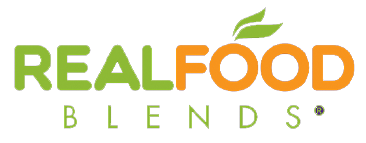ALS Awareness Month & Giveaway
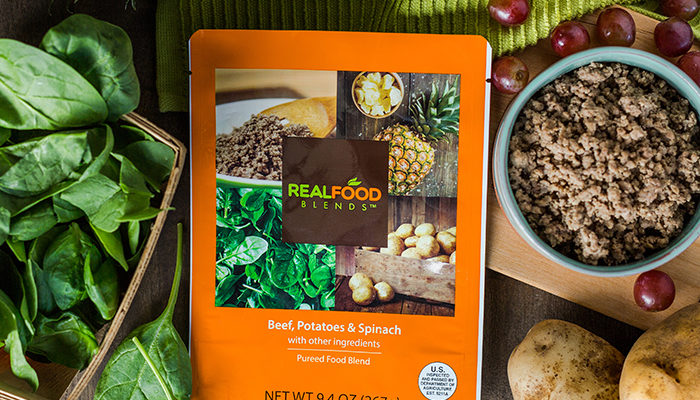
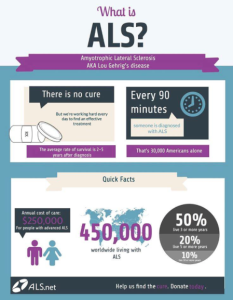 Today kicks off ALS Awareness Month. There are almost 500,000 people living with ALS right now, and most of them will require a feeding tube for nutrition at some point. We have been so honored that many our of customers with ALS have shared their stories with us, helping others afflicted with ALS know that real food is still possible after the feeding tube is placed.
Today kicks off ALS Awareness Month. There are almost 500,000 people living with ALS right now, and most of them will require a feeding tube for nutrition at some point. We have been so honored that many our of customers with ALS have shared their stories with us, helping others afflicted with ALS know that real food is still possible after the feeding tube is placed.
We have heard stories from many people with ALS and their caregivers that the decision of when to get the feeding tube is a hard one. Oftentimes the tube is looked at as a visual, permanent reminder that ALS has taken another pleasurable thing away from the person: the ability to eat and enjoy real foods. Our hope is that in some way, our meals can help give a feeling of normalcy and make the transition to tube-feeding a little easier psychologically while delivering the benefits of real food nutrition.
To help spread awareness about ALS this month and give back to those in our community fighting this horrible disease, Real Food Blends donate 5% of all proceeds from sales of our Sample Pack or Variety Packs to the ALS Therapy Development Institute (with code ALS.)
600 Meal Giveaway
We are looking for ten people who have ALS and have used feeding tube nutrition for less than one year who would like to try our meals. In exchange for filling out two brief surveys, we will provide 5 cases (60 meals) of Real Food Blends to each person. Please email info@realfoodblends.com if you would like to participate.
If you would like to learn more about ALS & how you can help spread awareness, some of our favorite sites include Augie’s Quest, the ALS Therapy Development Institute, and The ALS Association. Please help spread the word about about ALS & that those with ALS can still enjoy real food by sharing on social media via the links below.
Thanksgiving Dinner Blend Recipe For Tube-Feeding
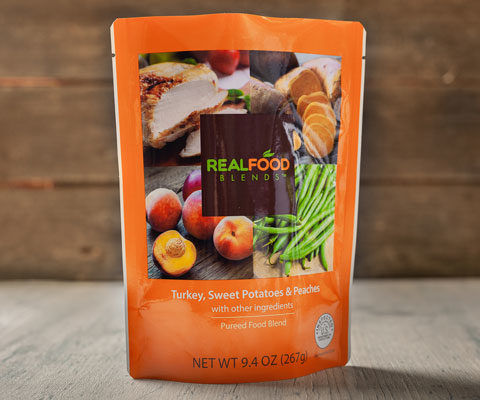
Thanksgiving – and the holidays for that matter – can be especially hard on tube-fed people and their families as everyone else is focused on FOOD! We firmly believe that if you are tube-fed and able to digest real food, there’s no need for them to miss out on Thanksgiving dinner. We’ve put together this quick & easy Thanksgiving dinner blend recipe to so your tube-fed loved one can participate in the meal too. Pull up a seat to that table & open up the tube!
For this recipe, we used one cup each of
- Turkey (take the skin off if you don’t have a very powerful blender)
- Mashed Potatoes
- Stuffing
- Cranberries
- Green Beans
And two cups of whole milk. (You can use any liquid you want, we used milk for the calories & since most people have on hand.)
- Put turkey and some milk into the blender and let ‘er rip.
- Add the rest of the ingredients in order, and the rest of the milk. Puree until smooth. The blend should be plenty pourable and easy to bolus feed.
Don’t forget to save the turkey bones for bone broth for blending!
Couple of notes:
- Notice we didn’t use a Vitamix or Blendtec. We wanted to make sure that a typical kitchen blender could blend well enough to fit through a regular feeding tube. (We tested on a 14 fr with no problem but recommend straining to make 100% sure you don’t clog the tube.)
- This is not medical advice or a recommendation. If you or your tubie have never had real food, Thanksgiving might not be the best day to try it.
- Use safe kitchen handling practices. Don’t use any food that’s been setting out for too long or leave the food out for too long after blending. If you wouldn’t eat it, don’t blend it.

One cup of each. Easy peasy.
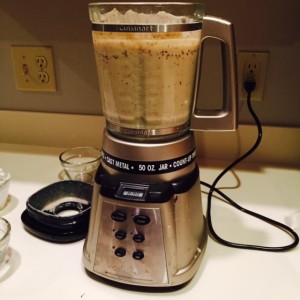
Mmmm, turkey.
Finally, although we firmly believe counting calories on Thanksgiving is un-American, here is the basic nutrition information & recipe we used. If you need more fat, throw in some gravy or butter or olive oil – or use the green bean casserole vs. plain green beans. More protein? Throw in more turkey. The recipe yields 40 ounces – about 5 – 8 ounce servings – enjoy the leftovers too! 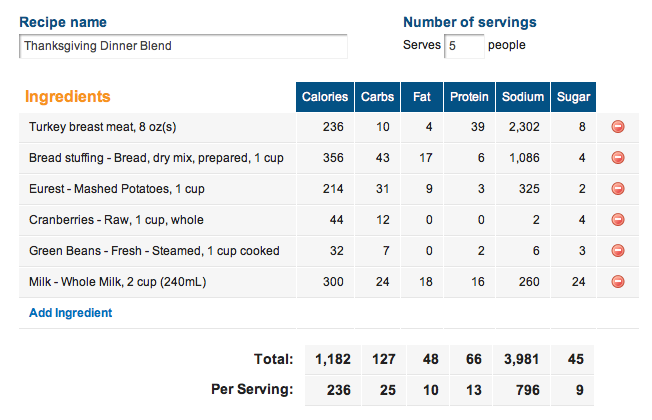
Enjoy! You’ve earned a tee shirt:
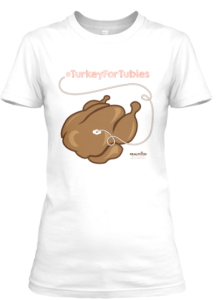
You really can buy this if you want: http://teespring.com/turkeyfortubies
Insurance Update
The insurance coverage picture for Real Food Blends is about as clear as mud these days! We are happy to report that more and more of you are having the meals covered by your insurance and provided directly from your DME (that’s a home health care company or Durable Medical Equipment company.) We wish this process was easier and we’re working to get coverage for as many tube-fed people as possible but these things take time. Here’s an update and answers to the most common questions about insurance coverage, and how you can secure coverage as well.
Why isn’t my DME willing to carry Real Food Blends?
First, they may just have not had anyone ask for it! This is a pretty simple problem to fix and usually the easiest way to have your insurer billed for the meals. Call your existing DME and tell them you would like them to verify your insurance coverage for HCPCS B4149. (Wholesale details are here.)
The second is a little more complicated but, like many things, boils down to money! Some state Medicaid programs don’t routinely cover formulas billed under this code. If the reimbursement rate isn’t published or if it’s really low, DMEs are unlikely to want to carry the meals as they need to be able to make some profit off providing the meals. If you are covered by another insurance or Medicaid is not your primary, it is still worth a call to your DME to ask for our meals / that they verify the insurance.
And finally, the last reason. Some of the larger DMEs have been unwilling to carry the meals despite customer demand for a variety of reasons (mostly, change is hard!) This tide is slowly changing, and the more vocal you all are about leaving a DME for one that will provide these meals, the more you are paving the way for those that come after you. One way you can help is to ask your RD to tell the sales reps from the big DMEs that they want the meals!
What can I do?
1 – Find a Local DME: Ask your medical team / dietitian for referrals to local DMEs. The smaller, local businesses have proven much more willing to go above and beyond for a customer, especially a new customer that has recurring medical needs. (If you are willing to switch your entire DME needs over to them, they are usually even more wiling to provide our meals as they make a much higher profit off the medical supplies than formulas typically. Make sure you tell your existing DME why you are leaving! (The list of current DMEs stocking our meals is here.)
2 – File for reimbursement. You can purchase the meals directly from us and use these steps to file for reimbursement from your insurer.
3 – Lobby your insurer. If you get a denial for our meals, either from your DME or for reimbursement, we can assist with the appeal process. Sometimes, under some plans, insurers will routinely deny any specialized formula on the first submission. During the appeal process, a real live human usually reads the reasoning for the special request and can use common sense to determine if the request should be approved.
4 – If your insurance is listed here, you can call Medline at 1-866-356-4997. They will verify your insurance coverage and ship out the meals directly to you.
What else to know?
Read through our insurance page to get more of an understanding about how insurance coverage / the reimbursement process works. And then get creative! We have some families using crowd funding to help pay for the meals (don’t be embarrassed, you’d be surprised how many people love having a tangible way to help!) Also, our monthly subscription program saves you 10% off the cost of the meals. Hope that helps clear up some confusion. Please reach out if you have any questions. We are here to help!
Blenderized Diet by Gravity
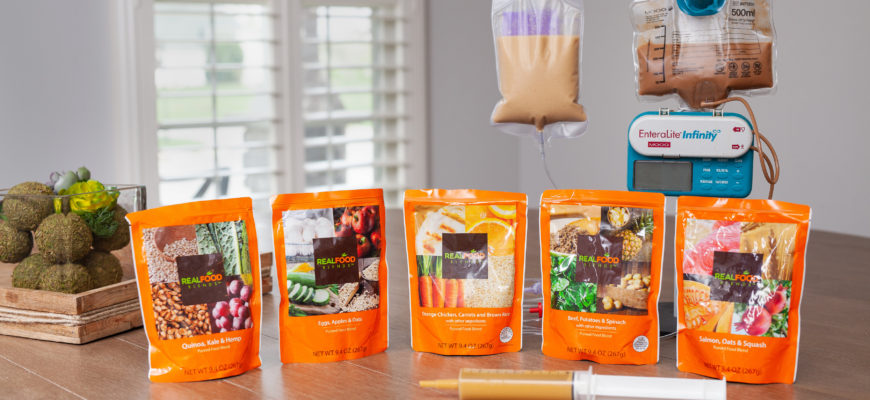
One of the most common questions we get from first time customers – or those that want to try our meals – is if the meals can go through a gravity bag or feeding pump. The answer is yes, with some adjustments.
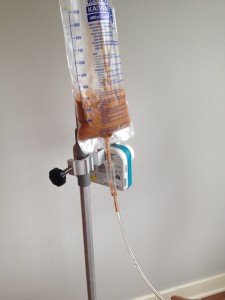
Salmon meal being gravity fed with 1 oz water.
Real Food Blends meals are intentionally thicker than traditional formulas. Not only does the thickness allow us to increase the calories per ounce, but also tends to help with a feeling of satisfaction, and improve reflux symptoms. Whenever possible, we recommend bolus feeding the meals with a syringe. Many people who can’t tolerate a bolus of formula can tolerate a bolus of real food. (We even have nurses in hospitals bolus feeding the meals now – one told me “I’d rather bolus a patient every few minutes than clean the inevitable diarrhea from the formula!”)
However, just like some people like their eggs over easy and some scrambled, these are your meals to feed how you see fit! If you want or need to use a gravity bag or pump, you’ll need to add extra fluid to make them flow well. Our recommendations follow:
Salmon : Add 1-2 oz. of fluid of choice.
Quinoa – Add 2 ounces of fluid of choice.
Chicken – Add 2 ounces of fluid of choice.
The fluid you add could be water, milk or milk alternatives, vegetable or fruit juice, or bone broths. Your meal, your choice, but make sure you are accounting for those calories if necessary.
If the bag stops dripping you may need to shake it around a bit to mix up the food as the heavier particles drop to the bottom of the bags, thanks to gravity.
Here is the chicken meal with 3 ounces water being gravity fed. You can see we still tried to maintain some thickness:
And the quinoa meal with 2 ounces of water added:
Enjoy!!
*The manufacturers of feeding pumps have specifically stated that their pumps are NOT to be used with anything but commercial formula so use a pump with real food at your own risk. This is not intended to be medical advice. Always check with your medical team before making any changes to an enteral nutrition program.
Cleaning Feed Tube Extension Sets

“Necessity is the mother of invention”. Truer words have never been spoken when it comes to living with a feeding tube. From the beloved squirrel syringes to modifying feeding pump bags, the feeding tube community often has the best tips and tricks to make the process easier. The one thing we can’t seem to agree on is the hands-down best way to clean the feeding tube extension sets!
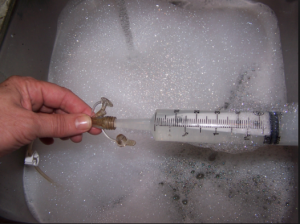
A tried & true method of cleaning a feeding tube extension.
We’ve reached out to the tubie community to find the best way to clean the feeding tube extension sets. Although there’s no one winner, some of the responses were downright ingenious. Instead of trying to summarize, here’s some of our favorite responses:
“I clean the bolus port part very gently with a flexible dental pick if needed.” –Lisa G.
Tanya H. got creative by sharing this, “I do the same beginning process that I do with my milking machine lines for milking goats…… first run very cold water thru tube lines first. Hot water will cook the milk/formula/feed onto the tube. Then I run hot soapy water thru. Then every day I soak in a solution of vinegar & water to disinfect. Use new extension every week.”
Jodi M. shares that “White vinegar works great followed by hot water flush.”
A more detailed way of cleaning with hot water and dish soap comes from Heather G. She says to “Soak in hot water, dish soap (Palmolive) and 2-4 denture tables (efferdent) for 30min. Rinse with hot water and air dry.”
Brittany H shares that “I roll the tube between my fingers to get the crud out…. and use a bottle brush (the end made for the bottle nipple) to clean out the top of the extension.”
”I was told don’t use anything you wouldn’t eat…and hot water with a mixture of 1/4 cup to 1tbsp baking soda. Works like a charm.” –Les R.
Eugena M. shares “I use dawn soup with a cap full of bleach soak a few hours and air dry.”
”I use an endoscopy brush and hot, soapy dishwater. It has a small end that fits regular extensions, a large end that fits bolus extensions. They are 6′ long so you can clean the 4′ Kangaroo tubing extensions as well. You can also use the large end (of a separate, designated one) to clean suction tubing.” –Liz A.
Patty M. says that “Once every couple weeks I run really hot water through them with a drop of antibacterial soap. Just have to make sure you run a lot of hot hot water through to get all the soap out. After each feed I always rinse out with just plain hit water.”
”We were taught to fill with coco cola and clamp off and let ‘soak’ for 12 hours then rinse while we were in the NICU after our little one got his tube. It works for cleaning and staying flexible!!” –Charissa R.
”Pepsi! And don’t put them in hot water. Any extreme temperatures seems to harden them. But, if they’re used frequently, start a new one weekly.” –Michelle C.
Cleanliness and hygiene is important so make sure however you are cleaning your feeding tube extension sets, your medical team is on board.
Did we miss a good feeding tube extension cleaning solution? Please comment here or on our Facebook page so we can share with others!




